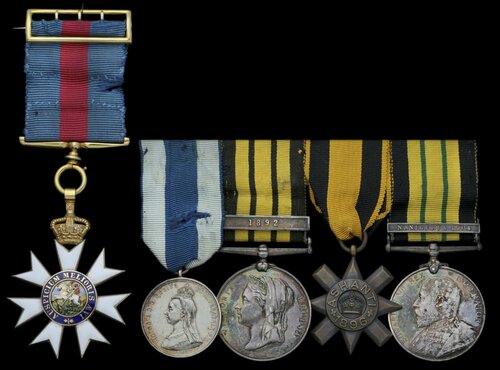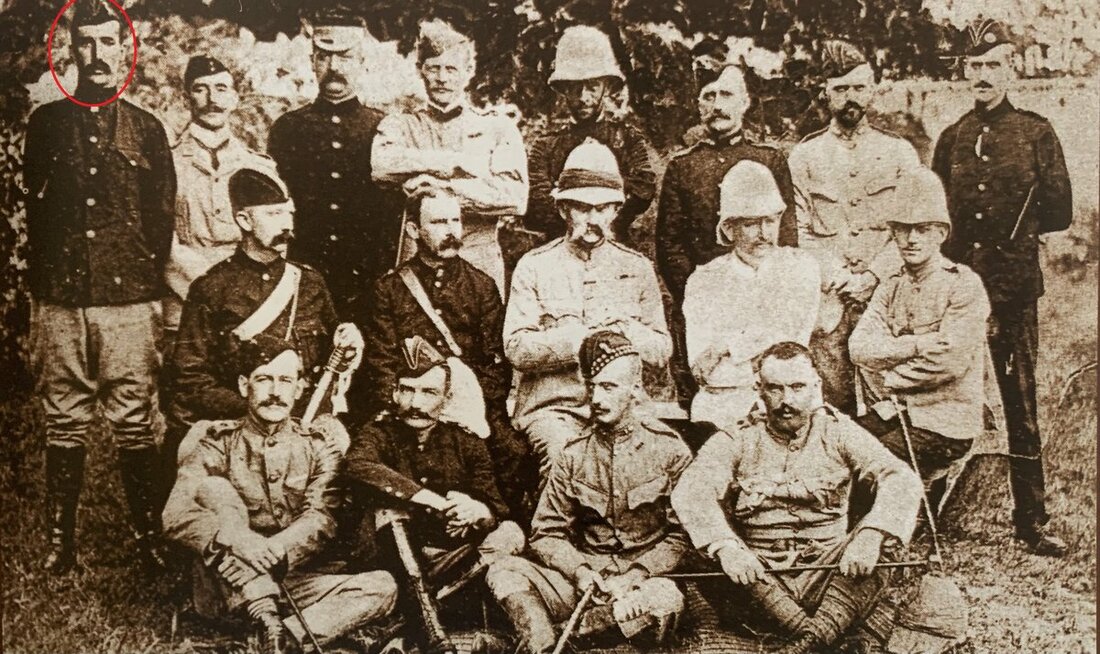Auction: 21003 - Orders, Decorations and Medals
Lot: 479
A rare Ashanti 1896 C.M.G. group of five awarded to Major H. D. Larymore, Royal Artillery, A.D.C. and Secretary to Colonel Sir Francis Scott and British Resident at Kumassi, later Resident in Northern Nigeria
The Order of St. Michael and St. George, C.M.G., breast Badge, silver-gilt and enamels, complete with ribbon buckle; Jubilee 1897, silver; East and West Africa 1887-1900, 1 clasp, 1892 (A. Inspr. Capt: D. H. Larymore. G.C. Constaby.); Ashanti Star 1896; Africa General Service 1902-56, 1 clasp, N. Nigeria 1904 (Resdt. Major H. D. Larymore. C.M.G. Political Dept.) some enamel chipping to the first, otherwise good very fine (5)
C.M.G. London Gazette 10 April 1896.
Henry Douglas Larymore was born on 16 September 1867, son of A. D. Larymore, late Deputy Inspector-General of Jails in Bengal. He was educated at Westminster School and joined the Army as a Lieutenant in the Edinburgh Artillery (Militia) on 5 October 1886, becoming Captain in February 1891. In that same year he was seconded for employment in West Africa and served with the Jebu Expeditionary Force in 1892, as Staff Officer and secretary to Colonel F. C. Scott, C.B., Commanding the Expedition (Despatches London Gazette 1 July 1892, medal with clasp, thanks of Government and Executive and Legislative Councils of Lagos). It seems his 'mention' probably sprung from his action at Asuom in February 1892, when alone with only Scott and a party of Houssas, thus just one Officer observed the event. Had a further observer been present, he may well have been put forward for a higher award:
'Sir Francis was suddenly disturbed by a great clamour, and going to the door of the hut he saw his troops surrounded by an armed, howling mob, mad with drink. The Houssas had formed into line and were loading their rifles, while the natives, who numbered a thousand or more, had loaded also, and in another minute shots would have been exchanged, when the little force must have been annihilated. Captain Larymore, however, dressed only in a suit of pyjamas, rushed in between the two bodies of men with his umbrella open. He gave orders for his men to unload and go into the hut, while he quietly stood, umbrella in hand, confronting the horde of savages. Quiet was restored, and the natives, after yelling considerably, retired. Had the Captain seized his arms and rushed out showing signs of alarm, the natives would have instantly opened fire, and no one would have been left to tell the tale.'
Larymore was next employed on various political missions to the Hinterland of the Gold Coast as Assistant Inspector in the Gold Coast Constabulary. He served in the Ashanti Expedition of 1895-96, in the operations against King Prempeh, on the Staff as Headquarters Camp Commandant and as A.D.C. to Colonel Sir Francis Scott (Honourably mentioned, Bronze Star, and nominated C.M.G. - one of just 5 such awards for the campaign) when the 'mention' stated:
'He is a very zealous and energetic officer with a great knowledge of the natives. He has been on service with me before, and I know him to be a really good officer.'
He subsequently acted as British Resident at Kumassi 1896-97, in which year he went to India with the Royal Garrison Artillery, as second-in-command of No. 11 Company at Rangoon. He served in the same capacity at Roorkee in 1898, and with No. 9 Company at Roorkee in 1899. That same year he took command of No. 24 Company at Delhi, and at Rawal Pindi in 1900.
Larymore returned to Sierra Leone in 1901, in Colonial employment. He was appointed 3rd Class Resident in Northern Nigeria in April 1902, becoming 2nd Class Resident in the following October, and attended Christ’s College, Cambridge, as Hausa scholar in 1903. Returning to West Africa, Larymore took part in the operations against the Semolika people of Northern Nigeria, with the expedition under Captain G. C. Merrick, R.A., in October 1904 (Medal with clasp). The roll entry states:
'Major Larymore accompanied the expedition from the day it left to the day of return & conducted the negotations with the Chiefs after the town of Semolika was taken.'
Larymore retired from the Army on 5 January 1907, but rejoined in January 1915 to serve on the Staff of Woolwich Arsenal as Inspecting Officer of Munitions, and later went to the U.S.A. in charge of the Explosives Section of the Munitions Commission. After the war he returned once again to West Africa to become Resident in Northern Nigeria. Major Larymore died on 30 January 1946. His wife, Constance, whom he married in 1897, had published in 1908, A Resident’s Wife in Nigeria, some extracts from which accompany the group together with a quantity of copied research, Colonial Office extracts and others related to his career.
Subject to 20% VAT on Buyer’s Premium. For more information please view Terms and Conditions for Buyers.
Sold for
£3,500
Starting price
£1900







